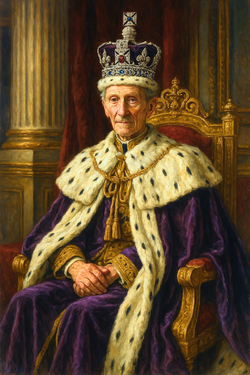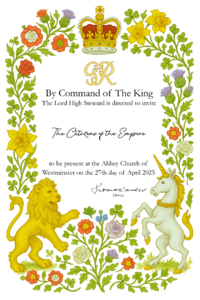Coronation of George VII

The Coronation of George VII as King of The Empire of Great Britain and other such realms took place on the 27 April 2025 at Westminster Abbey in London. Acceding to the throne on the 1 January 2025 following the abdication of his grandson, Charles III, he was proclaimed King by the privy council shortly afterwards. The Coronation, out of respect for the deaths of Charles III and Edward IX, took place later than expected. During the service, George took an oath, was anointed with holy oil, was invested with robes and regalia, and was crowned King-Emperor of the United Kingdom, Canada, Australia, New Zealand, and other dependent territories.
Celebrations took place amongst the realms of the Empire and both a commemorative coronation medal, official honours list, and the Royal Order of George VII were all established to celebrate the occasion. It was the most expensive coronation in the history of the region.
Preparation
The Coronation was originally discussed in the Royal Household through the Coronation & Transition Committee of the Prince of Wales, convened in October of 2024 to oversee the accession of John, Prince of Wales, to the throne of Great Britain on the 1 January 2025. It was announced to be in session on the 28 October 2024, and routinely met throughout the remaining months until January.
The deaths of HRH Prince Victor and HRH Prince Henry at the end of 2024, and the beginning of 2025, delayed Coronation preparation significantly, so as to appropiately mourn the two former monarchs.
The Executive Coronation Committee was officialy formed on the 2 April 2025: chaired by Josephine Carew, The Countess of Strathmore (Lord High Chancellor); vice-chaired by Thomas Carew, The Earl of Devon (Lord High Steward and Private Secretary to the Sovereign), and consisting of William, Prince of Wales; Charles Wright, The Viscount Kirkwall (as Prime Minister until the 21 April); James Forsyte, The Duke of Warwick (as Prime Minister from the 21 April) and Anastasia Nelson, Lady Hereford.
On the 17th April, Thomas Carew announced that the coronation would take place on the 27 April 2025. Invitations to key dignitaries were sent out the following day.
Event
The Coronation Ceremony of George VII followed traditional patterns and precedents set over more than a millenium of coronations of British, English, and Scottish monarchs.
Procession
Guests
Ceremony
Music
Celebrations
His Majesty hosted a royal banquet in the ballroom of Buckingham Palace in the evening following the coronation, of which a majority of the peers and politicians of the realms, and many foreign dignitaries, attended. The menu, one of the most comprehensive ever created for a Coronation was inspired partly by the banquet of King George IV. However, much of it was tailored to represent and showcase all the realms of the Empire, as well as to highlight the personal favourites of the King. Many of the dishes were prepared with produce from either the Royal Estates, or the Mapperton Estate, the private residence of the King.
At the end of the evening, The King announced the Coronation Honours List, which included two elevations to the peerage (The Earl of Devon and the Countess of Strathmore were made Marquess of Dorchester and Marchioness of Harewood respectively), as well as gongs for all members of the Coronation Committee and Royal Household. The George VII Coronation Medal was introduced, as was the Royal Order of George VII, whereby all members of the Royal Family, the Royal Household, and all Prime Minister's of the King were to be members.
The National Gallery opened a special exhibition, titled "Zadok the Priest" to commemorate the King and the coronation. Featuring six portraits including the Coronation Portrait, it drew significant crowds. The opening was attended by the Chairman of the National Gallery, Thomas Carew. The King and members of the Royal Family came to visit the following day.
As at the coronations of former monarchs, acorns shed from oaks in Windsor Great Park, near Windsor Castle, were shipped around the Commonwealth and planted in parks, school grounds, cemeteries and private gardens to grow into what are known as Royal Oaks or Coronation Oaks.
